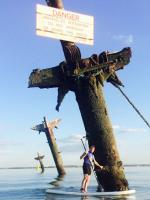 Anti-terror police in the UK are suddenly concerned that the SS Richard Montgomery, a Liberty ship which sank over seventy years ago loaded with high explosives in the Thames estuary, might be a potential target for terrorists. Reportedly, the government has been on high-alert to defend the wrecked ship.
Anti-terror police in the UK are suddenly concerned that the SS Richard Montgomery, a Liberty ship which sank over seventy years ago loaded with high explosives in the Thames estuary, might be a potential target for terrorists. Reportedly, the government has been on high-alert to defend the wrecked ship.
In 1944, SS Richard Montgomery ran aground and sank off the Nore sandbank, near Sheerness loaded with 1,400 tonnes of high explosives. Initial efforts to unload the ship’s dangerous cargo were partially successful but were abandoned after the ship began to break up. The remaining 1,400 tonnes of cargo was considered too dangerous to attempt to unload, so beyond periodic surveys and the placing of warning buoys and signs, little more has done in the intervening seventy-one years.
The ship and her high-explosive cargo are sitting in the Thames estuary, in about fifty feet of water, a few hundred yards offshore, between an oil refinery and gas storage facility. The ship’s masts are visible above the water at all tides. The wreck is marked with buoys and signs are affixed to the masts warning all to stay away. The area is reported to be patrolled and monitored by the Coastguard and Kent Police. How effective this security is was called into question when last August, a local paddleboarder Shane Skinner ignored the warnings and paddled over to the wreck to pose next to one of the masts. The photos, posted on Facebook, caused considerable controversy. Security is reported to have been ramped up since the Paris attacks of November.
What would happen if the explosives on the Richard Montgomery were to detonate? As reported by the BBC in 2004: If the ship exploded it would be one of the biggest non-nuclear blasts ever and would devastate the port, the report in the New Scientist magazine claims.
Mick Hamer, who wrote the report for New Scientist, told the BBC he felt there were two main options – to bury the wreck in sand or concrete or to move all or part of it.
But he said if the ship or its cargo was moved the whole of Sheerness would have to be evacuated because of the risk of explosion.
He said: “It’s as dangerous now as it has been for the last 60 years. There’s 1,400 tonnes of TNT on there, that’s about one twelfth the size of the atomic bombs dropped on Japan. It could blow up for a number of reasons – it could blow up spontaneously, it could blow up in parts or it could blow up the whole cargo. It could blow up because of terrorism, somebody might target it, or it could blow up simply because of bombs moving in the tide.”
In 1970, government tests on the site showed a blast would hurl a 1,000ft wide column of water, mud, metal and munitions almost 10,000ft into the air. The shock of the blast would shatter almost every window in Sheerness and damage buildings. The explosion would also generate a 16ft high wave that could sink a small craft.
According to a Maritime and Coastguard Agency report from 2000, the explosives aboard the Richard Montgomery are beleived to include:
- 286 × 2,000 lb (910 kg) high explosive “Blockbuster” bombs
- 4,439 × 1,000 lb (450 kg) bombs of various types
- 1,925 × 500 lb (230 kg) bombs
- 2,815 fragmentation bombs and bomb clusters
- Various explosive booster charges
- Various smoke bombs, including white phosphorus bombs
- Various pyrotechnic signals
Thanks to Alaric Bond for contributing to this post.

Someone should do a comparison of the explosives of the Halifax, NS explosion and those on this wreak. We know what happened in Halifax and maybe it would better quantify the dangers posed by this wreak
This is an area where I am definitely not an expert. That being said the relative explosive power of the Halifax blast was roughly twice the potential explosive power of the explosives on the Richard Montgomery, based on comparing the TNT equivalents in the published records. Also, unlike in Halifax, the explosives are under water and somewhat less likely to go off all at once. My guess is that while an explosion on the Richard Montgomery would be very bad, it would not approach the damage dome in Halifax. Anyone better informed than I, please chime in.
Pingback: Bommenwrak Theems terroristendoel | Bootjesgek.nl
Carrying 1,400 tonnes, but unloading the explosives partially successful, then it would no longer have 1,400 tonnes, it would have less than that.
As for the Halifax explosion, there has been plenty written about it, Google “Halifax harbor explosion”, here are two of many:
Photos: http://www.dailymail.co.uk/news/article-2841066/Unique-photographs-taken-WWI-sailor-biggest-manmade-explosion-history-two-warships-crashed-other.html
History: http://www.history.com/this-day-in-history/the-great-halifax-explosion
The reports of the cargo of the Richard Montgomery are contradictory. Liberty ships had a cargo deadweight of over 8,000 long tons. One source I read says that they discharged almost 6,000 tons leaving 1,400 aboard.
Would’t the expolsives deteriorate after being underwater for so long?
I have a hard time buying the 1970 government test results. I bet we could leave the wreck alone and nothing will ever happen.
Full disclosure: I have no training here, I just build model ships in bottles so I probably don’t know what I’m talking about.
Have a look at http://www.ssrichardmontgomery.com and links, for up to date information on the dangers the wreck presents.